Varicose veins are typically seen as unsightly blemishes under the skin. But treating these dilated blood vessels is about more than just appearances. Leaving varicose veins untreated can lead to a variety of serious medical conditions. Most patients with varicose veins report symptoms of itchiness, fatigue, pain and discomfort in the legs, and swelling of the skin. In most cases, these symptoms will only get worse if the patient chooses not to see a medical professional. Individuals that suffer from the condition should take a moment to learn about who to see for varicose veins and the dangers of leaving the condition untreated.
Why It's Important to Treat Varicose Veins
Every case of varicose veins is different. While some patients will see their symptoms worsen, others could be at risk of coming down with a range of more serious, potentially life-threatening conditions.
• Hyperpigmentation
If left untreated, varicose veins usually result in excess blood leaking into the tissues of the leg. The patient will experience painful swelling and inflammation as parts of their skin become dark and discolored. This condition is known as hyperpigmentation.
•Lipodermosclerosis
When the tissues of the leg are left inflamed for a long period of time, the tissues become firm and heavy. The patient might feel that their legs are becoming increasingly tender, making it more difficult to move or relax. Lipodermatosclerosis is the term used to define the stiffening or hardening of the leg tissues.
•Venous Leg Ulcer
Varicose veins usually result in a condition known as chronic venous insufficiency or CVI. Over time, CVI can result in what's known as a venous leg ulcer. This is when an area of the skin breaks down to reveal the flesh underneath. Venous leg ulcers tend to get larger over time, leading to increasing discomfort and irritation in the legs.
•Spontaneous Bleeding
Varicose veins tend to break down the walls of the skin over time. This brings the varicose veins closer to the surface of the skin. In some cases, the slightest scratch or scrape can lead to excess blood loss. While the bleeding is usually painless, patients may experience significant blood loss if the condition goes untreated.
•Superficial Thrombophlebitis
Superficial thrombophlebitis is a condition that involves the inflammation of the veins just beneath the surface of the skin. This results from the weakening of the veins and decreased blood flow. The patient may experience redness of the skin, an increasing tenderness of the vein, as well as ongoing pain or swelling of the legs.
•Deep Vein Thrombosis
Deep Vein Thrombosis is the most serious condition related to varicose veins. DVT usually results in what's known as a pulling sensation in the legs, stemming from a blood clot. The patient may feel as if their nerves are being pinched with increased redness and swelling in the legs. If the blood clot travels further up the body, the condition could be life-threatening.
While varicose veins can range from mild to severe, those that suffer from the condition should contact a board certified vascular surgeon. If neglected, varicose veins can have major implications for the patient's health.
Who to See For Varicose Veins
Patients with varicose veins should seek a licensed specialist in their area for an initial evaluation. Only aboard certified vascular surgeon will be able to best determine the severity of the case in question and whether or not additional treatment methods are necessary.
How to Fix Varicose Veins
Treating varicose veins all depends on the severity of the condition. In most cases, the damaged vein is removed entirely using a range of different treatment methods such as endovenouslaser ablation, micro-phlebectomy, or sclerotherapy. Most forms of treatment are relatively painless and can be performed in just a few short appointments.
